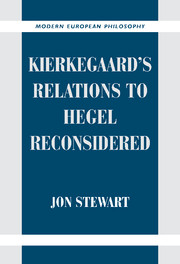Book contents
- Frontmatter
- Contents
- Acknowledgements
- Abbreviations of Primary Texts
- Preface
- Introduction
- 1 Kierkegaard and Danish Hegelianism
- 2 Traces of Hegel in From the Papers of One Still Living and the Early Works
- 3 The Ironic Thesis and Hegel's Presence in The Concept of Irony
- 4 Hegel's Aufhebung and Kierkegaard's Either/Or
- 5 Kierkegaard's Polemic with Martensen in Johannes Climacus, or De omnibus dubitandum est
- 6 Kierkegaard's Repetition and Hegel's Dialectical Mediation
- 7 Hegel's View of Moral Conscience and Kierkegaard's Interpretation of Abraham
- 8 Martensen's Doctrine of Immanence and Kierkegaard's Transcendence in the Philosophical Fragments
- 9 The Dispute with Adler in The Concept of Anxiety
- 10 The Polemic with Heiberg in Prefaces
- 11 Subjective and Objective Thinking: Hegel in the Concluding Unscientific Postscript
- 12 Adler's Confusions and the Results of Hegel's Philosophy
- 13 Kierkegaard's Phenomenology of Despair in The Sickness unto Death
- 14 Kierkegaard and the Development of Nineteenth-Century Continental Philosophy: Conclusions, Reflections, and Reevaluations
- Foreign Language Summaries
- Bibliographies
- Subject Index
- Index of Persons
4 - Hegel's Aufhebung and Kierkegaard's Either/Or
Published online by Cambridge University Press: 13 March 2010
- Frontmatter
- Contents
- Acknowledgements
- Abbreviations of Primary Texts
- Preface
- Introduction
- 1 Kierkegaard and Danish Hegelianism
- 2 Traces of Hegel in From the Papers of One Still Living and the Early Works
- 3 The Ironic Thesis and Hegel's Presence in The Concept of Irony
- 4 Hegel's Aufhebung and Kierkegaard's Either/Or
- 5 Kierkegaard's Polemic with Martensen in Johannes Climacus, or De omnibus dubitandum est
- 6 Kierkegaard's Repetition and Hegel's Dialectical Mediation
- 7 Hegel's View of Moral Conscience and Kierkegaard's Interpretation of Abraham
- 8 Martensen's Doctrine of Immanence and Kierkegaard's Transcendence in the Philosophical Fragments
- 9 The Dispute with Adler in The Concept of Anxiety
- 10 The Polemic with Heiberg in Prefaces
- 11 Subjective and Objective Thinking: Hegel in the Concluding Unscientific Postscript
- 12 Adler's Confusions and the Results of Hegel's Philosophy
- 13 Kierkegaard's Phenomenology of Despair in The Sickness unto Death
- 14 Kierkegaard and the Development of Nineteenth-Century Continental Philosophy: Conclusions, Reflections, and Reevaluations
- Foreign Language Summaries
- Bibliographies
- Subject Index
- Index of Persons
Summary
After his dissertation, the next work that Kierkegaard wrote was Either/Or, which appeared in two volumes under the name of the pseudonymous editor Victor Eremita in 1843 (i.e., two years after The Concept of Irony). It is the work that in Kierkegaard's own mind marks the beginning of his actual authorship. Either/Or was apparently begun during his stay in Berlin (from late October 1841 to early March 1842) and then completed during the months immediately following his return to Denmark. Kierkegaard ultimately finished the book in November of 1842, and it was published in February of the following year.
The subject-matter of the work overlaps in some respects with that of The Concept of Irony, but the way in which it is treated differs radically. Perhaps the most obvious points of contact can be found in the chapter on tragedy. Likewise, “The Seducer's Diary” has been thought to represent the ironic stance of Romantic individualism, as embodied by Friedrich von Schlegel's Lucinde, which is of course discussed in some detail in The Concept of Irony. Some see the entire account of the esthete in Part One as corresponding to the irony of the Romantics. Likewise the section entitled, “Rotation of Crops,” seems to be a portrayal of Romantic nihilism, which is criticized in The Concept of Irony. Aside from these points, much of the content of Either/Or departs from that of the dissertation.
- Type
- Chapter
- Information
- Kierkegaard's Relations to Hegel Reconsidered , pp. 182 - 237Publisher: Cambridge University PressPrint publication year: 2003

